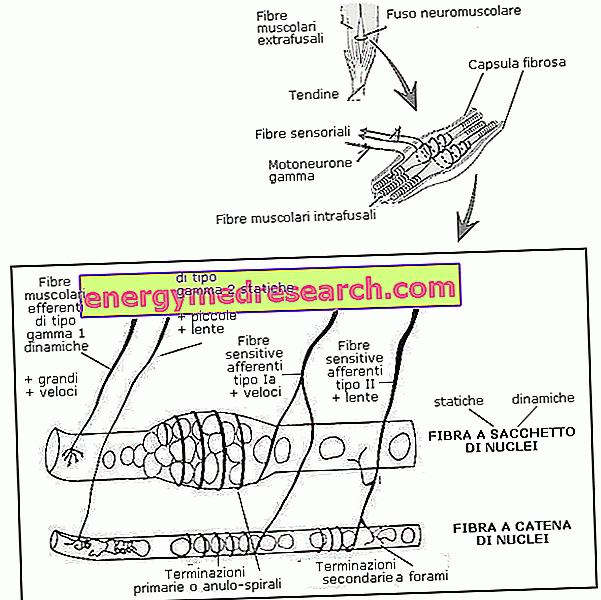The neuromuscular spindles are stretch receptors located within the voluntary striated musculature; with their activity they are able to capture the state of stretching of the muscles and to send the information gathered to the spinal cord and to the encephalon. The activity of the neuromuscular spindles is therefore very important both to prevent injuries related to excessive elongation, both to maintain normal muscle tone, and to perform fluid movements in a harmonious and controlled manner.
All the skeletal muscles, with the exception of a mandibular muscle, contain within them various neuromuscular spindles, which are particularly concentrated at the level of the mastication muscles, the spine, the eyes, the limbs and the hands. Here, the neuromuscular spindles, about 5-10 mm long, are arranged in parallel with the ordinary muscle fibers and thanks to this particular "side by side" arrangement they are able to capture the degree of elongation.
Anatomy
The neuromuscular spindle consists of a capsule of connective tissue that wraps around a small group of muscle fibers (from 4 to 10), equipped with a "special" cytological structure; these fibers are often called intrafusal, to distinguish them from the ordinary ones, which, for a level playing field, are given the adjective "extrafusali".
The physiology of intrafusal fibers is explained, first of all, by examining in detail the anatomical structure. At their extremes they are quite similar to ordinary fibers and contain contractile striated fibrils for this. The real difference lies in the equatorial portion, which appears enlarged, devoid of myofibrils and rich in stretch-sensitive sensory endings, immersed in a gelatinous substance.
It is said, therefore, that the fibers of the neuromuscular spindles are effector to the two poles (they contract in response to a nervous stimulus) and emitters in the center (from which they send information on the state of lengthening).
From the anatomical point of view, the intrafusal muscle fibers are divided into nuclear bag fibers (also called bag or bag fibers) and nuclear chain fibers. The former have a dilated central area, rich in nuclei. On the other hand, nuclear chain fibers have an elongated nuclear distribution, always concentrated in the equatorial region, but also extended in the periphery; they are also shorter and thinner than the previous ones.
From the anatomical point of view, the sensitive terminations of the neuromuscular spindle are arranged, partly by rolling up to the median region (anulum-spiral or primary terminations) and partly forming a sapling branch in the neighboring regions (flower or secondary terminations).
The primary terminations are thicker, have a high conduction speed, belong to the class of Ia fibers, and depart from both the sack and nuclear chain fibers; the secondary terminations, belonging to the class of type II fibers, are instead thinner, less fast in the propagation of the impulses and innervate mainly the chain fibers of nuclei.
From a physiological point of view, on the other hand, we distinguish fast-conduction sensitive fibers (type Ia) and slower-conduction sensitive fibers (type II). The former, despite having terminations on both types of fiber, are anular-spiral terminations characteristic of bag-fiber fibers of dynamic nuclei (see below). The slower fibers II, on the other hand, have anular-spiral terminations which wrap the bag-fiber fibers of static nuclei and the chain fibers; also flowering endings belong to this category.

Unlike extrafusal muscle fibers, which receive afferents from alpha motor neurons, the spindle fibers contract under the action of gamma motoneurons (nerve fibers coming from the anterior horn of the spinal cord characterized by a small caliber).
CONTINUE: Physiology of neuromuscular spindles »



